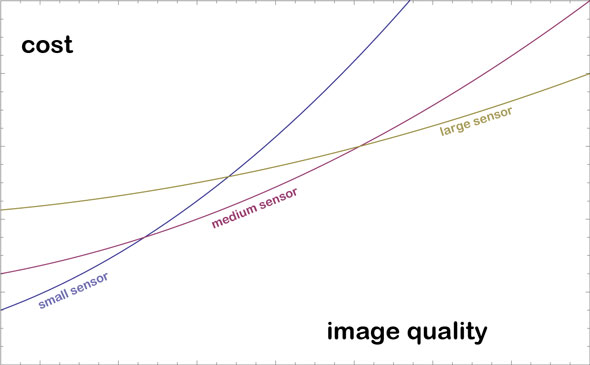You can turn and twist it as much as you want. In the end physics can’t be cheated and size still matters. The smaller a sensor = the more compromises you burden yourself with (except if you’re a diehard macro photographer because you’ll love the smaller sensors’ greater depth of field). These past years I’ve shot all kinds of sensors and formats. As an early adapter of Four Thirds, its first CCD sensor (Olympus E-M1) rendered beautiful images, but forget it in difficult light and the high ISO department. The gap between the performance of different sensors has since been narrowed down dramatically. Still. The 35mm equivalent is a format hard to beat. Go larger and the lenses become monstrous. Go smaller and still enjoy great imagers — APS-C is considered to be digital photography’s standard of reference. But there’s hardly any alternative for whomever tasted full-frame and ideally shoots prime glass to avoid the cumbersome weight of zooms. And there’s a sweet spot of image quality where full-frame cameras deliver the most cost-efficient solution.
Whether we really need more full-frame or not is up for discussion. Yes, it is the job of marketing to breed constant discontent, so that people will always want to buy more and something new. Fact is, I’m a more happy photographer with a large sensor and proper glass. Let it all be mirrorless (but OVF pleeease, EVFs’ are just not there yet), and I promise, I’ll be completely satisfied.
Fuji Rumors suggests full-frame is the way Fujifilm chooses for future X series releases. Remember, back at CP+ Fujifilm conceded they might even be forced to compete head on against professional full-frame cameras. Senior management told DP Review:
Inevitably yes, we have to compete against full-frame. The professional market is very segmented, and for example for sports photography I think the X-T1 is already competitive. So yes, I’d like to challenge full-frame.
Add Sony’s A7(R)s with the A9 in the pipeline, probably announced around Photokina this autumn.
Wouldn’t even count out Olympus with similar ambitions — and the Nikon Df is only a first foray by world’s number two camera maker into full-frame territory that will become more populated over the course of the next years.
Size is the main drawback to beat. Mirrorless will make the dreams become reality. Production costs for full-frame imagers are down — and the struggling camera industry dearly needs new selling stimuli. Looks like a fait accompli, 35mm as tomorrow’s digital photography sensor size standard.
If you don’t really care about image quality, then the smaller sensor always wins. With increasing demand, larger sensor options still cost more, but in the end they become more cost efficient overall. That’s why it’s wise to always go for the better glass. Because glass lasts. Camera’s don’t.

To be on the safe side: each camera system has its own pros and cons. If you’re reasonably sure though you can’t resist the temptation of a promising 35mm offering some time down the road, better stop buying crop format lenses. Canon and Nikon full-frame mirrorless are unavoidable.
Problem’s the legacy flange focus distance — which is the most likely reason why the two dominant market players hesitate to jump into the mirrorless full-frame fray. They’d upset loyal users who might switch sides because they’d be forced to buy new lenses anyway.
Exciting times ahead. Time to hedge glass and read the signs of the times. There is a sweet spot of image quality where full-frame cameras deliver the most cost-efficient solution today. And the cost-efficiency only gets better.


